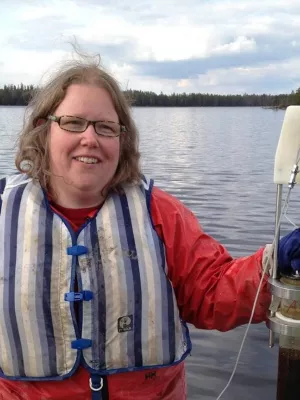
Anne Nielsen
Projektkoordinator

Evaluating the effect of flowering age and forest structure on pollen productivity estimates
Författare
Summary, in English
Pollen productivity estimates (PPEs) are indispensable prerequisites for quantitative vegetation reconstructions. Estimates from different European regions show a large variability and it is uncertain whether this reflects regional differences in climate and soil or is brought about by different assessments of vegetation abundance. Forests represent a particular problem as they consist of several layers of vegetation and many tree species only start producing pollen after they have attained ages of several decades. Here we used detailed forest inventory data from north-eastern Germany to investigate the effect of flowering age and understory trees on PPEs.
Pollen counts were obtained from 49 small to medium sized lakes chosen to represent the different forest types in the region. Surface samples from lakes within a closed forest of Fagus yielded disproportionate amounts of Fagus pollen, increasing its PPE and the variability of all other estimates. These samples were removed from further analysis but indicate a high trunk-space component that is not considered in the Prentice–Sugita pollen dispersal and deposition model. Results of the restricted dataset show important differences in PPEs based on the consideration of flowering age and understory position. The effect is largest for slow growing and/or late flowering trees like Fagus and Carpinus while it is minimal for species that flower early in their development like Betula and Alnus. The large relevant source area of pollen (RSAP) of 7 km obtained in this study is consistent with the landscape structure of the region.
Pollen counts were obtained from 49 small to medium sized lakes chosen to represent the different forest types in the region. Surface samples from lakes within a closed forest of Fagus yielded disproportionate amounts of Fagus pollen, increasing its PPE and the variability of all other estimates. These samples were removed from further analysis but indicate a high trunk-space component that is not considered in the Prentice–Sugita pollen dispersal and deposition model. Results of the restricted dataset show important differences in PPEs based on the consideration of flowering age and understory position. The effect is largest for slow growing and/or late flowering trees like Fagus and Carpinus while it is minimal for species that flower early in their development like Betula and Alnus. The large relevant source area of pollen (RSAP) of 7 km obtained in this study is consistent with the landscape structure of the region.
Avdelning/ar
- Kvartärgeologi
Publiceringsår
2012
Språk
Engelska
Sidor
471-484
Publikation/Tidskrift/Serie
Vegetation History and Archaeobotany
Volym
21
Issue
6
Fulltext
- Available as PDF - 735 kB
- Download statistics
Länkar
Dokumenttyp
Artikel i tidskrift
Förlag
Springer
Ämne
- Geology
Nyckelord
- flowering age
- surface samples
- pollen productivity estimates
- Germany
- relevant source area of pollen
- forest structure
Status
Published
ISBN/ISSN/Övrigt
- ISSN: 0939-6314

